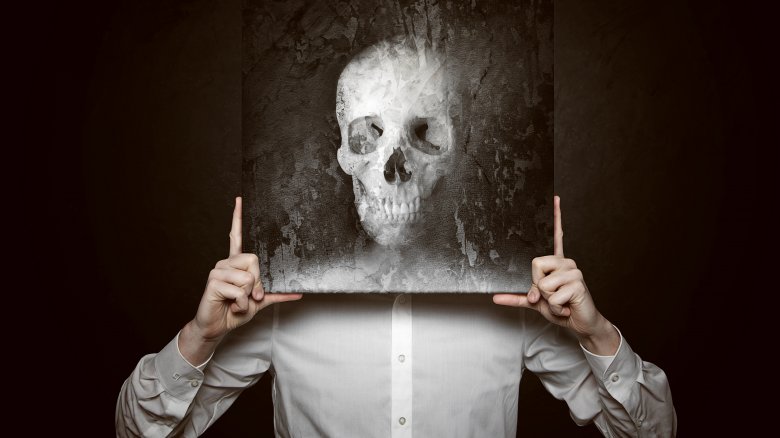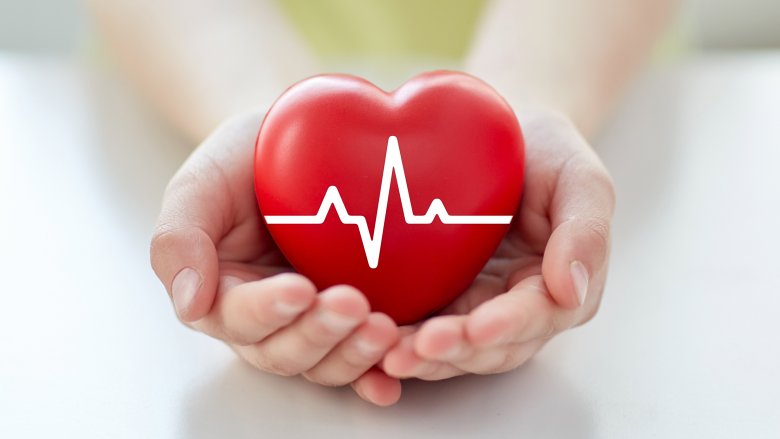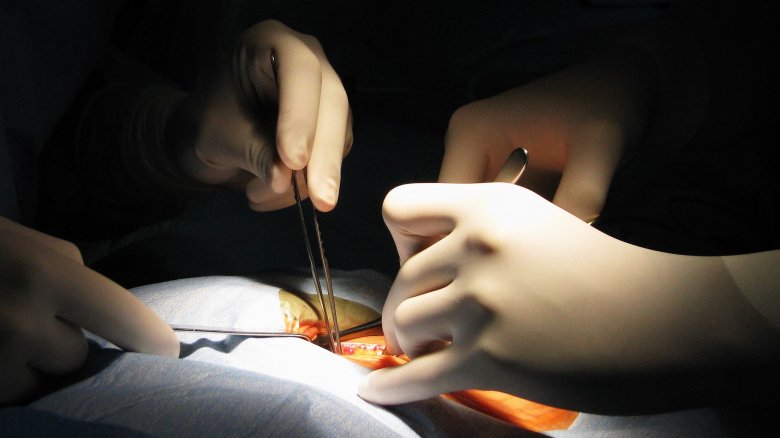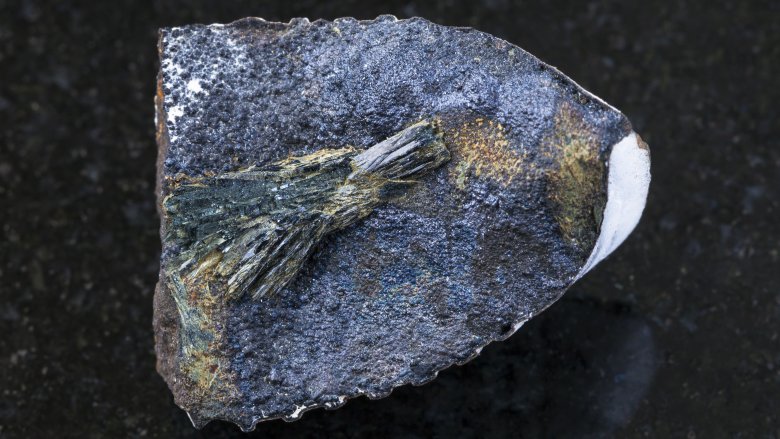Bizarre Things That Happen To Your Body After You Die
Many people would rather lop off their legs than kick the bucket. Unfortunately, even the limbless bite the dust. You can swallow that dust docilely or fight your demise like there's no tomorrow. Either way, you'll have a last yesterday. But that doesn't mean you'll suddenly stop existing. When you die, your body embarks on an odd odyssey filled with fascinating happenings. Don't think of it as your life extinguishing but as an extreme anatomical makeover. You might not get to see the end result, but here's a sample of the crazy things that could occur.
Your heart might refuse to die
Movies often make death look instantaneous. Dying characters might rasp words emphatically or wordlessly gasp dramatically in their final moments, but once they die, they basically become rubbery rocks. Every hint of vitality vanishes as if someone hit a hidden kill switch on the human body. But real corpses sometimes cling to life long after they're officially lifeless. They have demonstrably dead brains, yet their hearts and other organs seem to function unencumbered. They can't think or see, but they can pee. These seemingly undead decedents aren't bed-wetting zombies, but enduring corpses known as "beating heart cadavers."
Per the BBC, "to qualify as a beating heart cadaver, the entire brain must be dead," including the brain stem. Without a working brain stem, breathing and other bodily processes should cease. However, in the 1950s, physicians began noticing that some of the patients they had deemed comatose were actually brain dead. Strangely, these cadavers delayed decay.
A skeptical brain might attribute this freaky phenomenon to the advent of ventilators and other medical devices. But "long before life support" existed, presumably flummoxed physicians observed that certain patients' hearts pumped "for several hours after they stopped breathing." While such occurrences are incredibly uncommon, UCLA neurologist Alan Shewmon dug up 175 separate examples of bodies that "survived for more than a week after the person had died." One reportedly functioned for two decades. So rather than resting in peace once you die, pieces of you may stubbornly insist on living.
Your heart might restart itself
Mortality hinges on minutes and seconds, blood and oxygen, luck and loss. If your heart stops long enough, so does the rest of you. But just how long is "long enough"? As the book What We Leave Behind described, oxygen-starved brains sometimes start eating themselves after four minutes. So once your ticker quits, death generally comes quickly. But if you're like 78-year-old Walter Williams, your heart might buck the odds and pull a Lazarus.
CNN reported that Williams had seemingly breathed his last breath on a Wednesday night in March 2014. After deciding that the man was rigor mortis-bound, a coroner sealed the septuagenarian in a body bag and hauled him to a funeral home. But Williams had a surprise up his sleeve. Evidently unimpressed with death, he un-died and started writhing in his body bag. Miraculously, the coroner didn't have a heart attack. The best guess is that Williams' heart somehow restarted via a defibrillator he'd previously had inserted under his skin.
Williams might have had help from hidden jumper cables, but some resurrections seem inexplicable. In 2013, ABC recounted the unlikely revival of 37-year-old Anthony Yahle. Yahle's heart froze for 45 minutes, prompting his doctor to declare him dead. But just when it seemed that the Reaper completed another harvest, he returned to the land of the living. Yahle didn't recall his ordeal and somehow reawakened unscathed. If you're lucky, your heart will prove equally unbeatable.
Your brain might know you're dead
Even if your heart doesn't go on like the theme from Titanic, your demise might still show signs of after-life. For instance, your brain may remain intact long enough to realize that you died. According to CBC contributor Mark Beaulieu, a survey of 2,060 cardiac arrest survivors conducted by the Stony Brook University School of Medicine suggested that people who come back from the great beyond can sometimes recall resuscitation. In other words, multiple patients who technically passed away stayed awake during their dirt naps.
To clarify, these weren't people whose hearts simply took an extended break from beating. Researchers determined that "after all signs of bodily life as we recognize them had stopped, the brain stayed 'aware.'" Nonetheless, temporary corpses could vividly remember the measures taken to rescue them. Unfortunately, these postmortem memories can be devastating for people with die-hard brains. People who flat-out flat-lined often suffered PTSD during recovery. They couldn't cope with the shock of being shocked by defibrillators and witnessing the mad scramble to undo death.
The percentage of patients who were completely cognizant of kicking the bucket was pretty low: only 2 percent of survivors surveyed showed "full awareness." However, 46 percent of respondents described at least some level of awareness. They felt fear, experienced "violence/persecution," or perceived a "bright light." Some also recalled "floating above" their own bodies. This raises unsettling questions about what it means to die. What if some supposed stiffs are only mostly dead?
If you donate your organs, your corpse could appear to feel pain
The existence of brainless, beating hearts and heartless, die-hard brains arguably creates a definitional dilemma. U.S. physicians, for instance, declare death in accordance with the Uniform Determination of Death Act, which lists two independent criteria: "(1) irreversible cessation of circulatory and respiratory functions; or (2) irreversible cessation of all functions of the entire brain, including the brain stem." But if brains can still think after the heart halts, and hearts can keep chugging after the brain breaks, do separate parts of the body have "lives" of their own?
It's a queasy question to consider, especially when applied to organ donation. According to the BBC, "organs such as the lungs, liver and heart cannot be removed if a patient's heart has stopped." Simply put, only beating heart cadavers can be deceased donors. However, these technically brain-dead bodies almost appear to feel pain when you slice them open. As anesthetist Philip Keep explained: "You stick the knife in and the pulse and blood pressure shoot up." In fact, unless a dead donor is sedated, "the patient will start moving and wriggling around."
If a fresh corpse can tell that it's dead, can it also somehow sense when it's being raided like a meat buffet? Answers vary. Many medical professionals consider a deceased donor's mid-surgery movements and internal fluctuations "involuntary reactions" rather than genuine pain responses. Others uncomfortably wonder whether cadavers can feel the cutting. You may have to wait until you die to learn the truth.
You could turn into soap
Semantic ambiguity might make lifelessness look illusory, but decomposition shows otherwise. You're clearly not alive once you become compost. Not all decaying bodies get that far, though. Through the magic of morbid chemistry, some corpses turn into soap-sicles.
According to Atlas Obscura, cadaver fat sometimes interacts with anaerobic bacteria "in a damp, alkaline environment" (such as when water leaks into coffins) during a process called saponification. The result is a soap-like or waxy substance called adipocere. Accumulating adipocere envelops the body and allows human remains to remain relatively intact in the form of a "soap mummy." These bacteria are like little Tyler Durdens in an underground fright club. Only, instead of making soap from the stolen fat of liposuction patients into soap, the tiny Tylers target the departed.
Saponification has some positive ramifications. Rather than merely rotting, your corpse could in theory become a cleaning product or candle wax. In fact, this happened in practice in late 18th-century France. As Scientific American described, improperly interred bodies transformed into fat heaps, prompting King Louis XVI to shut down the country's cemeteries in 1775. The French soon began storing corpses in the country's now-iconic catacombs and changed lingering body fat into soap and candles.
There are arguably also moral implications. Saponification suggests that fattiness is close to cleanliness, which is close to godliness. By the transitive property of piety, that should make obese people godlier than thin ones. Eat that in moderation, health nuts.
You may emit a refrigerator coolant
Your body's postmortem utility extends beyond soap and candles. As described in the above YouTube video by Scientific American, if your body does fully decompose, it will release an array of useful molecules. Freshly dead, oxygen-deprived cells fill with carbon dioxide. The acidity of carbon dioxide destroys cell sacs, releasing enzymes into the body. These enzymes begin dissolving your carcass, producing a nutrient-rich, "blister-like" fluid. According to the book What We Leave Behind, this process amounts to internal altruism. Instead of clinging to every last life-preserving nutrient, "a cell's last act is to digest itself and liberate its nutrients so they can be used by others."
Your body's attempt to outlast death doesn't last long. After roughly a week, bacteria and fungi swoop in to ingest your nutrient-rich remains. Your sour smorgasbord of a corpse soon emits a cocktail of more than 400 chemicals, including the refrigerator coolant Freon. It also creates compounds like benzene, which is found in gasoline, and carbon tetrachloride, which was once used in fire extinguishers and for dry cleaning. As The Independent noted, it's also possible to turn human fat into biodiesel (yet another potential positive of obesity). If humans can get past the awkwardness of processing belated loved ones for commercial purposes, you or someone you know could end up helping to cool a refrigerator or power a car.
Your body could get hotter
When your body rots, it not only produces a refrigerator coolant, it literally cools down. Per Popular Science, without food and oxygen to fuel homeostatic processes, corpses reliably decrease in temperature ... except for when they don't. In numerous harrowing instances throughout history, rather than losing heat, a deceased someone gets markedly warmer. The phenomenon is called postmortem hyperthermia, and it's pretty inexplicable.
Old-timey physicians used to fear that sudden temperature spikes in corpses preluded spontaneous combustion. This suspicion amounted to hooey, but science hasn't provided a serviceable alternative theory, either. Cadavers can "catch heat" independent of room temperature or state of dress. Certain internal stressors like drugs, brain, trauma, and "excited delirium" might appear to play a role, but their specific impacts are unknown.
Since science is at a loss, attempts to explain postmortem hyperthermia usually boil down to "metabolic processes." Experts have also posited that "bacterial metabolism" and "insufficient thermal loss" are to blame. There may be some credence to the idea that bacteria factor in since gut microbes continue breaking down food when your body breaks down. And the body's fluid-producing self-digestion might also account for added thermal energy. But such explanations raise the counter question of why bodies typically lose heat. In the end, the answers offered seem questionable. Lifelessness, like life, might always be a mystery.
Hidden microbes emerge to eat you
As crappy as it sounds, you could become poop one day. Unless you're cremated or preserved, maggots, worms, your body's germs, and ravenous animals might feast on your future corpse. But those aren't the only organisms eager to bite you once you bite the dust. Man-eating microbes emerge from the ground to break you down.
What's striking about these diminutive death-eaters is that they seem to strike no matter where you perish, per Science Magazine. Researchers at University of Oregon in Eugene arrived at this conclusion after testing short grass prairie, subalpine forest, and desert soil samples from Texas and Colorado. Without fail, whenever a corpse was present, the same sets of invisible critters cropped up by the thousands and began snacking. This held true whether it was winter or spring and regardless of whether the festering flesh belonged to a mouse or a man.
The findings were equal parts eerie and interesting. The microbes are practically imperceptible until something drops dead, meaning that countless unseen creatures are literally waiting around for you to do just that. Their apparently constant presence might also account for why corpses seem to have a unique smell. The same stink-producing organisms seem to munch on everyone.
It might be unnerving to think that right now you're likely surrounded by beings that want to make a meal of you. But at least you know you'll always have company, even if some of your guests are just dying for you to die.
Your body might grow blue crystals
As with all aspects of life, what happens to you after death partly depends on your environment. Ubiquitous microbes might be chomping at the bit to rend you to bits, but dropping you in lava won't have the same overall effect as dipping you in chocolate and plopping you in a candy store. In the former scenario, you disintegrate; in the latter, you inspire cannibalism. In a not-so-similar vein, if your final resting place is waterlogged and saturated with iron, your body could acquire blue bling.
Per Atlas Obscura, these macabre decorations are vivianite crystals that form through the intermingling of water, iron, and phosphates contained in a corpse. As the process progresses, vivianite minerals transition from transparence to having a blue hue as oxygen joins the fray. This trippy transformation is further aided by bacteria. (Perhaps you're their equivalent of blue cheese.) Blue blotches subsequently occur on teeth, bone, skin, and proximate surfaces.
One of the more famous examples of vivianite-covered corpses was a centuries-old Swiss dude discovered in Switzerland's Lake Brienz, according to Live Science. He had become a mishmash of corporeal soap and blue crystals, and was horrifyingly headless. Investigators revealed that he likely drowned in a sediment-rich area, got masked by that earthy matter, and was later unearthed by earthquakes. That's not an ideal demise, but on the bright side, he was preserved in style.
You might give birth to a baby
The Lion King taught us that life is a circle, so it only makes sense that dying is vital to the living. You eat things, and other things eat you. It's science. But what Elton John and all those cartoon lions left out is that death also imitates life. As you've seen, the organ donor cadavers can jerk (but hopefully not twerk) on the operating table and occasionally sustain organ function for lengthy periods of time. Eeriest of all, dead bodies can also give birth.
As Discover Magazine detailed, burial sites can occasionally gain extra occupants thanks to postmortem fetal expulsion, or "coffin births." Obviously, this only occurs among a certain subset of corpses, but that shouldn't make it less salient. It's not every day that death literally seems to create life. Of course, there are crucial differences. Coffin babies aren't alive, and the mechanics of birthing them differ dramatically from how living infants are born.
Coffin births result from gases gathering in the body. These gases eventually expel the internal contents of a corpse, including smaller corpses. It's sad, but simultaneously life-affirming. When you kick the bucket, your legs don't instantly stop working. Your body continues abiding by the laws of nature, no matter how unnatural the outcome may seem. If anything, death demonstrates in its own macabre manner that life goes on, even when you're no longer alive.









